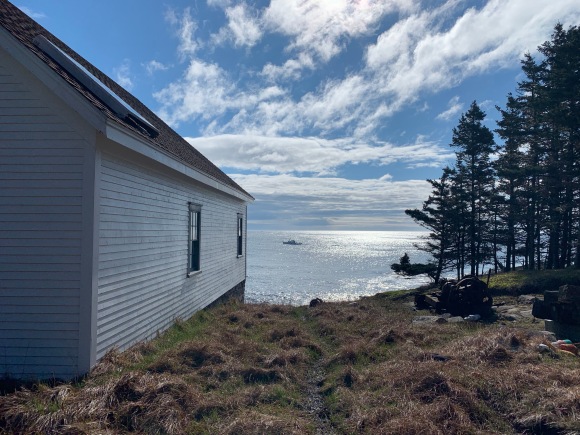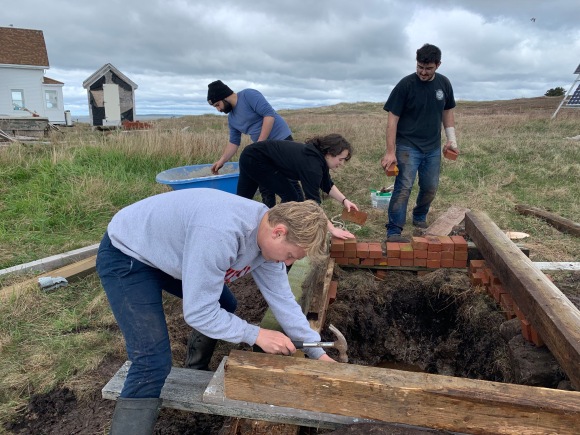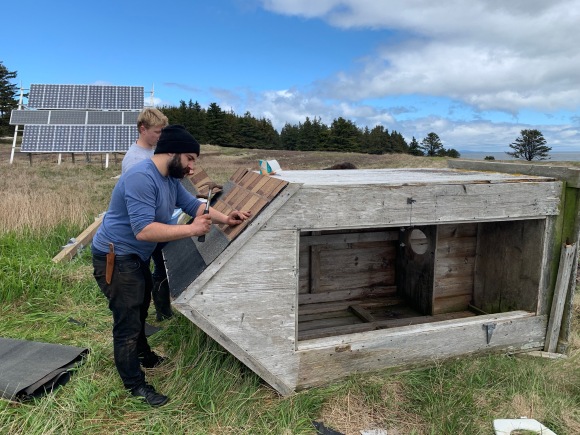I built a pit latrine on Great Duck Island yesterday and it was one of the most rewarding experiences of my to-date eight year journey as president of College of the Atlantic. Either the bar for my presidency was set really low, or there’s more than meets the eye with this little endeavor.
I didn’t really build the latrine—the structure itself was already there. And I didn’t build it—it was a collaborative project between me and several COA students and alumni. I may have nominally been the designated leader because of my age and title, but leadership was widely distributed.
COA’s Alice Eno Research Station is perched on the southern end of Great Duck Island, about eleven miles south of the town of Northeast Harbor on Mount Desert Island, Maine. Every summer for the last two decades, about six COA students, one faculty member, and a handful of guests are out there working to understand the ecology and natural history of sea birds. In so doing, they poop and pee quite a lot and can fill up a pit pretty quickly. The goal was mundane and utilitarian: they needed a new pit.

Osprey, in the distance, and the GDI Boat Shed
There’s not a whole heck of a lot of soil on Great Duck Island and there’s even less soil on the southern reaches where the lighthouse, keeper’s house, and most of the bird nesting action goes on. Any pit latrine project is most often a futile search for cavities in the granite bedrock. If you can tunnel to three feet you’re doing great. Getting to that depth for us was about cutting through the thick sod, extracting head-sized boulders, and scraping through some clay before quickly striking bedrock with a pick or rock bar in a way that sends an electric shock through the hands, arms, and shoulders. It’s very clear when you hit bedrock.
So, with a 2.5 foot pit dug in about an hour, with zero confidence that we could dig another pit any deeper, and with six hours before the Osprey (COA’s research vessel) returned to pick us up, we were moved-by-the-spirit to, a) try and build up if we couldn’t go down and b) give the current outhouse structure a face lift.
Here’s the thing about islands: it takes a lot of effort to get stuff there. And once stuff is there, it’s generally worth keeping it there because, almost regardless of what it is, you’re likely to need it at some point in the future. In other words, islands inspire hording. The Coast Guard built a generator shed on Great Duck in the 50s and that bunker-like building has become the repository for decades of hording. That shed was our pallet: nails, old roofing materials, older siding, rusted corner braces, wheelbarrows with flat tires, old paint, and the like.
The outhouse structure itself—a four by four foot wide by eight foot high encasement of a toilet seat, which we would later dub the Iron Throne in anticipation of the series finale of Game of Thrones—had been blown over sometime during the winter. It rested, a bit forlorn, about twenty yards from our pit. We were able to coax the thing uphill by “rolling” it; whatever structural integrity the thing had was left downhill.

Build up if we couldn’t dig down
So, with the Iron Throne still resting on its side but at least close to its new orifice, we proceeded to build upward. With old brick, sod, clay, head-sized boulders, two-by-fours, four-by-fours, six-by-sixes, and other timbers whose dimensions had been violated by time and the elements, we formed a rectangular perimeter around the hole in the ground. Anything made of wood on Great Duck was armed with rusted, bent, and tetanus-ridden metal. It looked like a poorly designed but very lethal trap, and, as the pit itself began to fill with the seepings of what had been a very wet spring, if the armaments didn’t kill you, the water just might.
But our foundation was remarkably resilient and, with a detached perspective, quite beautiful. In elevating the Throne about eighteen inches, it also might mean another year or so of utility. We then set to improving the structure itself. I had suggested to former GDI researchers that we should just build a new outhouse. That idea was met with contempt. As with any good outhouse, one develops very strong bonds with the built environment. It must be the reptilian brain activities of defecation and urination welded together with the frontal-cortex-heavy philosophizing that happens therein.
The only “good bones” left in this structure were sentimental, but those were wildly important and so must be saved. With a rusted hammer meant for driving pencil-sized nails, an equally rusted hand saw, and with—thankfully—a chain saw and ambitious sawyer, we set to work. For four hours we made the thing right: still full of sentiment, but a better barrier between your functioning human self and the night, the rain, and the eyes of fisherman in the not-too-distant waters of the Gulf of Maine.

Roofing the forlorn Throne
We also made the thing about two-hundred pounds heavier. The left over cedar clapboard wasn’t too bad, but, wow, asphalt shingles are really heavy. We stood proudly around our accomplishment, but quickly realized we now were faced with the daunting task of lifting and situating this top-heavy behemoth onto the raised walls around the pit. Failure at this point would have been a complete, humiliating failure—not the “isn’t it nice to learn from your mistakes” kind. It would have been an ironic failure, with the important human orifices, the orifice of the structure, and the orifice in the ground separated by an inseparable gulf.
Inspired some by the worry of such failure and irony, everyone on the trip—including those who had been occupied with bird counts and the like—put a shoulder to the task. Using strategy, levers, and brute force we narrowly avoided putting the structure inthe pit and managed to put it onthe pit. It was beautiful and functional, but it wasn’t done.
We wanted to be sure those detached from the production of the Iron Throne would also see it as beautiful. The paint we had was spoiled and likely toxic. The entrance to the Iron Throne was steep and definitely not anywhere close to code—even in the island sense of the word “code.” The most beautiful thing we had plenty of (beyond comradery, perhaps) was sod. During that last hour we all became inspired sod harvesters and encased the lower flanks of our outhouse in sod and even managed a set of sod steps. With Osprey just pulling up to the boathouse, we were now truly finished and truly satisfied.

Not a bad view
***
I’d like to conclude this short piece with just a bit of reflection on what I will call a project-based approach to learning. I’m refraining from the moniker experiential learning because it conjures people learning by holding hands in a meadow somewhere and absorbing experience auto-didactically. A project makes things real and I feel strongly that the learning outcomes of our Iron Throne project are real, measurable, describable, important, and replicable. As someone interested in education and as a college president at a place like College of the Atlantic, I want to put a lot more thinking behind those “real, measurable, etc.” characteristics. I’ll just scratch the surface here and ask that you look for my forthcoming (read: very much in the future) book on the subject to get the full story. The chapter headings of such a book might look like this:
- Material. I think we live too much in our heads. Projects can force us into the world of materials, but aren’t purely material in nature. Whether a pit latrine or a poem, they do involve a heavier emphasis on construction rather than deconstruction, and that feels very appealing in today’s day and age.
- Product. Projects produce products and there’s certainly something to be said about turning an idea into reality, whether that’s a business plan or a budget. We all experienced, perhaps to varying degrees with me on the “most excited” end of the spectrum, a pride in completion with our latrine.
- Understanding of time. Projects allow participants to drill down into their understanding of time—time in terms of budgeting time and deadlines, but also in terms of projecting and prognosticating into the future. What does it mean, for instance, for our latrine project to be sustainable into the future? What does ‘deferred maintenance’ mean? These questions certainly apply to material-heavy projects like latrines, but they’re also important for more abstract, spiritual projects.
- Physical. Closely related to Chapter One, projects tend to emphasize the importance of movement and kinesthetic intelligence. Again, we terribly undervalue these pieces of our unified, holistic intelligence. My shoulders are sore and bruised from the latrine project and I wouldn’t want it any other way.
- Cooperation. Projects can be solitary and might in those cases require a kind of self-cooperation with different parts of the brain or between competing demands on time or among various emotional preoccupations. But some of the most pedagogically powerful projects are done by more than one person. Negotiating a task in a group is one of the most important things you can learn, in my eyes. Our own experience with the latrine was, also in my eyes, an excellent example of cooperation working well. I had a lot of early questions that started off with “Should we …” or “Could we …” and after my third, “I don’t know, what do you think?” we were off to the races in terms of highly functioning cooperation.
- Tool-use. Yes, this may begin with screwdrivers and hammers, but good projects force participants to think about both physics and technique, but also about more profound means and ends.
The latrine project was fun, because I like digging around in the mud, because Great Duck Island is beautiful, and because I like variation in my life. It was also fun, because COA folks are adventurous and I like spending time with them. The latrine project was fun because it was useful and it’s nice to imagine researchers out on Great Duck having a relatively comfortable, very scenic place to do their business. But there’s a depth to the latrine project much more profound than the 2.5 feet we tunneled into the bedrock. I will continue to explore and work on this idea of a project-based approach to education and give meat to an idea that, in my mind, has been unfortunately mostly skin and bones.
Thanks to John, Chloe, Matt, Addison, Toby, Nice, Gaelen, Jenna, Elijah, Jenny, and Mikey. It was a great day.
